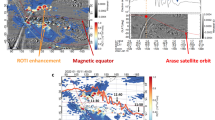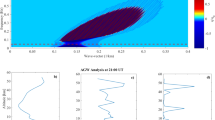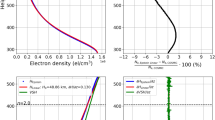Abstract
FOR a plane Earth and horizontally stratified ionosphere, Breit and Tuve's theorem1 gives the relation between the effective oblique path-length P′ travelled by a radio-wave packet and the corresponding ground-range D as: P′ = D sec Δ where Δ is the angle of elevation of the ray path relative to the ground. Provided that the electron density within the layer is a function of height only and that there is no imposed magnetic field, this relation is rigorously true for any density–height profile.
This is a preview of subscription content, access via your institution
Access options
Similar content being viewed by others
References
Breit, G., and Tuve, M. A., Phys. Rev., 28, 554 (1926).
Appleton, E. V., and Beynon, W. J. G., D.S.I.R. Rad. Res. Spec. Rep. No. 18 (1948).
Shearman, E. D. R., Proc. Inst. Elec. Eng., 103, B, 210 (1956).
Forsterling, K., and Lassen, H., Z. tech. Phys., 12, 502 (1931).
McCue, C. G., Austral. J. Phys., 9, 454 (1956).
Author information
Authors and Affiliations
Rights and permissions
About this article
Cite this article
GETHING, P. Relation between Oblique and Ground Path-lengths in Ionospheric Propagation over a Curved Earth. Nature 193, 260–261 (1962). https://doi.org/10.1038/193260a0
Issue date:
DOI: https://doi.org/10.1038/193260a0



